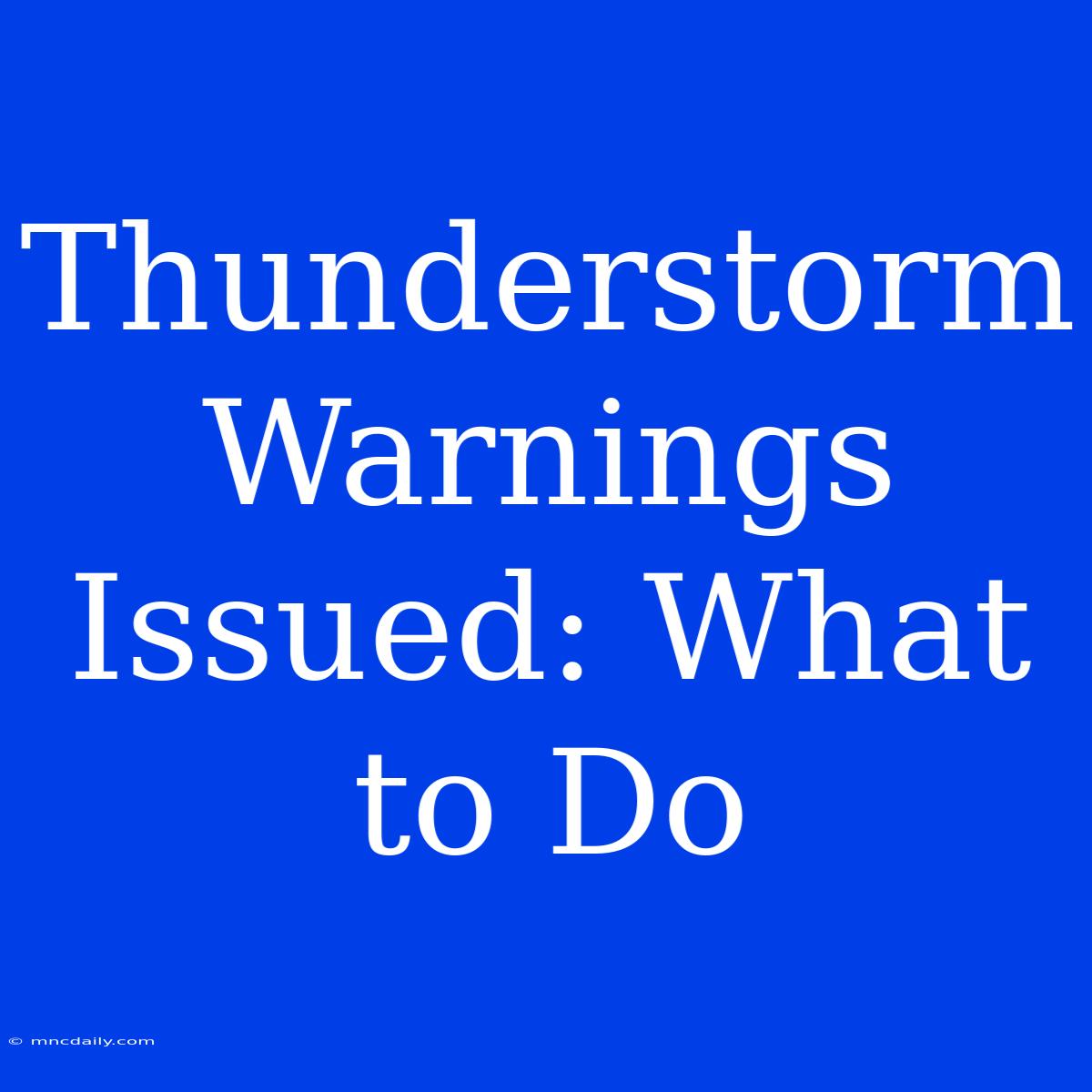Thunderstorm Warnings Issued: What to Do When the Sky Turns Dark
Have you ever wondered what to do when a thunderstorm warning is issued? Thunderstorms are powerful forces of nature that can bring strong winds, heavy rain, and dangerous lightning. It's important to be prepared and know what to do to stay safe during a thunderstorm.
Editor Note: Thunderstorm warnings are issued when severe weather conditions are imminent. This information is crucial for staying safe and mitigating risks associated with thunderstorms.
Understanding the Dangers: Thunderstorms are a common occurrence, but they can pose significant risks. Lightning strikes are extremely dangerous and can cause serious injuries or even death. Strong winds can damage property, and heavy rain can lead to flooding.
Our Analysis: We delved into the latest research and expert advice to compile a comprehensive guide on navigating thunderstorms safely. This guide explores key aspects of thunderstorm safety, including what to do when a warning is issued, how to find shelter, and essential preparedness tips.
Key Takeaways for Safeguarding Yourself During Thunderstorms:
| Aspect | Description |
|---|---|
| Understanding Warnings | Recognizing thunderstorm warnings from official sources like weather alerts and emergency broadcasts. |
| Seeking Shelter | Finding safe indoor shelter during a thunderstorm, particularly avoiding open areas and tall trees. |
| Lightning Safety | Practicing lightning safety guidelines by staying away from windows, water, and electrical appliances during a thunderstorm. |
| Protecting Property | Taking steps to protect your property by securing loose objects and securing outdoor furniture and equipment. |
| Stay Informed | Staying updated with the latest weather information through reliable sources to monitor the duration and intensity of the thunderstorm. |
Thunderstorm Warnings
Thunderstorm warnings are issued when severe weather conditions are imminent, typically including strong winds, heavy rain, and lightning. These warnings are issued by meteorological agencies like the National Weather Service (NWS) in the US or similar organizations worldwide.
Key Aspects:
- Understanding the Warning: Thunderstorm warnings are serious and should be taken seriously.
- Stay Informed: Obtain the latest information about the storm's path and severity.
- Take Action: Implement appropriate safety measures based on the warning information.
Seeking Safe Shelter
Finding a safe, enclosed space during a thunderstorm is paramount. Avoid open areas, tall trees, and bodies of water.
Key Aspects:
- Indoor Shelter: The best protection is a sturdy, enclosed building.
- Stay Indoors: Remain inside until the storm passes, avoiding windows and doors.
- Alternative Shelters: If a building is not available, seek a cave, a deep ditch, or a low-lying area.
Lightning Safety
Lightning is a major hazard associated with thunderstorms. Knowing how to stay safe during a lightning storm is crucial.
Key Aspects:
- Avoid Open Areas: Stay away from open fields, high ground, and tall trees.
- Distance From Water: Avoid bodies of water during thunderstorms.
- Inside Precautions: When indoors, stay away from windows, water sources, and electrical appliances.
Protecting Your Property
Thunderstorms can damage property, especially during heavy winds and rain.
Key Aspects:
- Secure Objects: Bring in or secure loose objects that could be blown away.
- Protect Furniture: Cover outdoor furniture or bring it inside.
- Prepare for Flooding: Take steps to prevent or mitigate flooding in your home.
Stay Informed
Staying informed about the weather is essential before, during, and after a thunderstorm.
Key Aspects:
- Weather Forecasts: Monitor weather forecasts and warnings from reliable sources.
- Emergency Broadcasts: Pay attention to emergency broadcasts and alerts.
- Stay Updated: Keep abreast of the latest information throughout the storm.
FAQ
Q: What is the difference between a thunderstorm watch and a warning? A: A thunderstorm watch means conditions are favorable for thunderstorms, while a warning indicates that a thunderstorm is imminent or occurring.
Q: How long does a typical thunderstorm last? **A: ** Thunderstorms can vary in duration from a few minutes to several hours.
Q: How can I protect my electronic devices from lightning strikes? A: Unplug electronic devices during a thunderstorm and avoid using them.
Q: What should I do if I'm caught outside in a thunderstorm? A: Seek immediate shelter in a sturdy building or low-lying area. Avoid tall trees, open fields, and bodies of water.
Q: Is it safe to drive during a thunderstorm? A: Driving during a thunderstorm can be dangerous. If possible, avoid driving and seek shelter.
Q: What should I do after a thunderstorm? A: Check for any damage to your property and report any power outages to your utility company.
Tips for Safeguarding Yourself During Thunderstorms
- Stay informed: Monitor weather forecasts and warnings from reliable sources.
- Seek shelter: Find a sturdy, enclosed building or low-lying area during a thunderstorm.
- Avoid open areas: Stay away from open fields, high ground, and tall trees.
- Stay away from water: Avoid swimming, boating, or fishing during thunderstorms.
- Disconnect electrical appliances: Unplug electrical devices and avoid using them during a storm.
- Secure loose objects: Bring in or secure loose objects that could be blown away.
- Protect your property: Take steps to protect your home and belongings from damage.
Thunderstorm Safety: A Summary
Thunderstorms are a powerful force of nature that can be dangerous. Knowing how to stay safe during a thunderstorm is crucial for protecting yourself and your property. By staying informed about weather forecasts, seeking shelter promptly, and following lightning safety guidelines, you can minimize your risk of harm.
Closing Message: Staying informed about weather conditions and taking proactive steps to prepare for thunderstorms can make a significant difference in ensuring your safety. Remember, when a thunderstorm warning is issued, act quickly and decisively to protect yourself and your loved ones.

